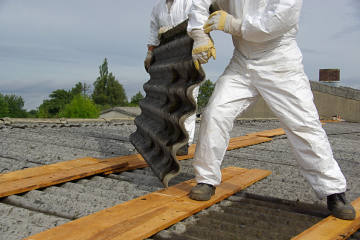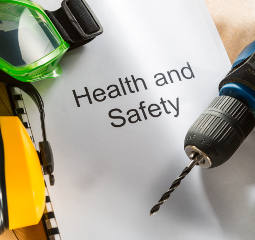
One of the important roles of a Chartered Building Surveyors’ practice such as Bradley-Mason LLP is to assess older buildings for the presence of potentially dangerous materials. For decades, the construction industry has prioritised certain materials over others for their desirable properties – be they strength, insulation, flame retardance or more. Sometimes, however, the quest for the ideal building material leads contractors to use products that may be unsafe. In this article, we focus on five such hazardous materials that we need to look out for when conducting building surveys and dilapidation surveys in the UK.
Commercial Asbestos
Everybody knows the risks caused by asbestos. Throughout much of the 20th century, until it was finally banned in 1999, asbestos was widely used as a building material due to its excellent insulation and fireproofing properties. Even now, our commercial asbestos surveyors still come across asbestos in pipe and boiler insulation, fireproof coatings, roof coverings, flooring materials, asbestos guttering and downpipes. Unfortunately, the fine fibres present in commercial asbestos – so excellent for the retention of heat – are incredibly harmful to humans. Asbestos is now known to cause respiratory problems known as asbestosis and is even a carcinogen; the material is, of course, no longer used in modern buildings.

Lead paint
Lead paint had been used in commercial and residential properties for decades before it was first banned back in 1978. Lead was used as an additive to improve the durability and appearance of house paint before the true toxicity of the metal was fully understood. Alarmingly, lead-based paint can stunt growth, damage the central nervous system and hold back development in young children and, unfortunately, the product tastes sweet which can encourage children to put lead paint products in their mouths. While lead paint has been banned in the UK for decades, some older properties still contain rooms treated with the product.
Lead piping
Lead is an incredibly versatile material, and aside from being used as an additive in paint it was the primary material for domestic and commercial plumbing for centuries. The same knowledge that spelled the end of lead-based paint in the 1970s also stopped the material from being used to make pipes, so no new buildings utilise lead-based plumbing today. That said, a high proportion of old buildings still contain lead piping, a fact we need to be conscious of when conducting Building surveys and Dilapidations surveys here in the UK.

Pressed wood panelling
Pressed wood panelling was extremely popular in commercial offices and even many homes throughout the 1970s, but the material has mercifully slipped out of fashion in the years since. As well as looking desperately dated, many pressed wood products contain urea-formaldehyde resin – a highly toxic product associated with respiratory problems and perhaps even cancer. Modern pressed wood products are strictly regulated to reduce the risk of formaldehyde exposure to humans.
Fibreglass insulation
Fibreglass insulation was initially introduced as a replacement to commercial asbestos, as the man-made product boasted many of the same attributes that made the natural insulator so popular in the first place. Fibreglass insulation, however, is not without its problems. Despite the fact that numerous healthcare organisations have deemed the product safe to use in homes and commercial properties, there are those who believe that the tiny fibres can contribute to significant health problems in humans, particularly in areas where it’s likely to be disturbed frequently. Fibreglass is an irritant and must be handled with great care when being installed or removed.
As you can appreciate, even many newer buildings can contain dangerous substances, such as the five mentioned above, that must be carefully handled when commercial properties are surveyed here in the UK. Contact us to arrange an asbestos survey, building survey or dilapidation survey of your commercial property – we know exactly what we’re looking for and will ensure that your business remains safe and compliant throughout the process.
DISCLAIMER: This article is for general information only and not intended as advice. Each project has its own set of unique circumstances, all potential issues should be investigated by a surveyor on a case by case basis before making any decision.



